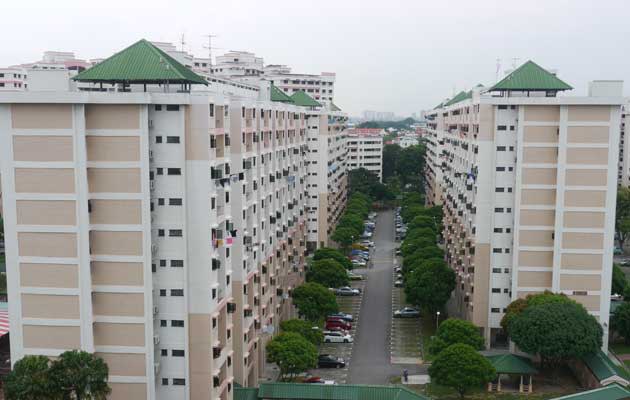COMMENT: Flats affordable — so why is HDB building more rental flats?

Back in March 2006, the government vowed that it “will not provide large numbers of rental flats, even if low-income families are clamouring for them.”
“National Development Minister Mah Bow Tan explained that housing policy in Singapore will remain geared towards home ownership,” the Straits Times reported then. “This is why the HDB has consistently priced its flats to be affordable to 90 per cent of the population and made grants and loans available to help first-time home buyers.”
In 2009, Mr Mah further tightened the qualifying criteria for these flats to "reinstate the public rental scheme to its rightful role as the final safety net and the housing option of last resort for the needy.”
"If everybody jumps onto this safety net, whether they deserve to or they don't, that safety net is going to break,” he said.
Applicants who had sold a flat would have to wait at least 30 months before they are eligible to apply for a public rental flat, which is heavily subsidised by the government. The new criteria included taking into account not just a tenant's income but also assets such as savings, whether they previously owned private property, and whether their children owned HDB flats with spare rooms.
Many Members of Parliament were asking for the government to provide more rental flats for the needy, many of whom had appealed to their MPs for help.
Some MPs were therefore disappointed that the government was tightening the criteria.
“Mdm Cynthia Phua (PAP-Aljunied) expressed dismay at this proposal, emphasising that in times of economic downturn, the Government ‘should have more love’ instead of tightening the rental housing criteria for old folks. Mr Mah responded, saying that the purchase of a $90,000 two-room flat is ‘easily affordable’ to someone earning $1,200.”
Nonetheless, Mr Mah promised that the government would build a further 8,000 rental flats by 2012, to bring the total number of such units to 50,000.
However, two years later, in 2011, Mr Mah’s successor at the Ministry of National Development (MND), Mr Khaw Boon Wan, saw it differently, after his own encounters at his Meet-the-People sessions with single mothers and divorcees who couldn’t afford to buy flats.
“It’s quite clear in my mind [that] we need to ramp up the building of rental flats as quickly as we can,” he said. “Not just by a few thousand, actually we need to build by tens of thousands, and the earlier the better.”
So, in Parliament in September 2013, the government announced that it will be building another 10,000 rental flats by 2017 – bringing the total to 60,000.
Those in the queue would no doubt welcome the news, as this will shorten their waiting time. Some have had to wait for 21/2 years just to be eligible to apply, and then had to further wait between 7 to 12 months to actually get a flat.
What should be of concern is the increased demand for such flats, which seems to run counter to various observations and claims by government ministers in recent times.
For example, Deputy Prime Minister and Finance Minister, Tharman Shanmugaratnam, said in March that “a family with a monthly income of as low as $1,000 can now purchase a small flat.”
His remarks raised some eyebrows. Subsequently, Mr Khaw had to explain that Mr Tharman was referring to new two-room flats. But some still doubt Mr Tharman’s claims.
And in August, the Acting Minister for Culture, Community and Youth, Lawrence Wong, assured Singaporeans that Singapore's household balance sheets are in "good shape".
“Most heavy borrowers in Singapore have above average income levels, which means they are less likely to default on their loans,” Channel Newsasia reported Mr Wong as having said.
And just last week, the Sunday Times reported that those “who have been defaulting on their Housing Board (HDB) home loans has halved from five years ago.”
So, the question is obvious:
If HDB flats are affordable to anyone with as low a salary as S$1,000 a month, if our household debt-to-income ratio “are not more stretched than they were in the last decade”, and if fewer people are defaulting on their housing loans, why are we seeing an increased demand for cheaper rental flats, and especially in the past five years or so?
The reversal from Mr Mah’s vow in 2006 to “not provide large numbers of rental flats, even if low-income families are clamouring for them”, to Mr Khaw’s urgent promise in 2011 that “actually we need to build by tens of thousands, and the earlier the better”, it seems that there is an underlying problem with the affordability of our public housing flats for the lower-income, contrary to what the government may claim.
If more have to turn to rental flats – which is a “housing option of last resort”, as Mr Mah put it – then perhaps we should take a deeper look and get to the root cause of this. Will building more such flats, which is a welcome move, solve the problem of more Singaporeans having to depend on such housing?
Andrew helms publichouse.sg as Editor-in-Chief. His writings have been reproduced in other publications, including the Australian Housing Journal in 2010. He was nominated by Yahoo! Singapore as one of Singapore's most influential media persons in 2011. The views expressed above are his own.
Related links:
HDB to ramp up rental flat supply
More HDB flats up for rent
10% of elderly flat owners rent out, sublet units


